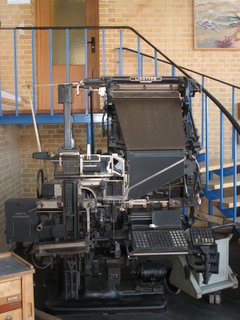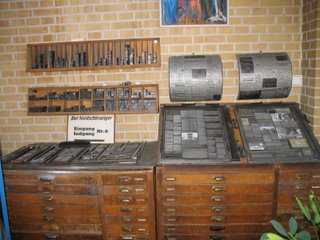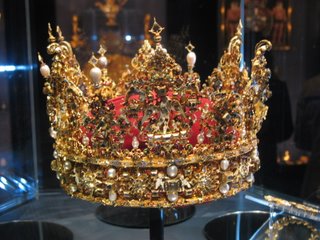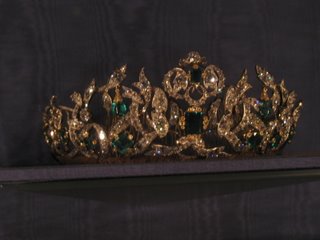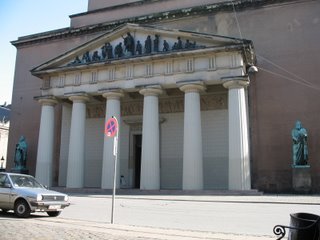Dansk avisen
I had no idea when I chose Denmark to study abroad in that I would land here in the middle of the most exciting time for newspapers here in many decades.
They call it the newspaper war, a catchy enough title to give those of you who don't really care about newspapers some idea of how important the situation is.
And through DIS, I've had the chance to learn quite a bit about the war and to hear things I otherwise wouldn't It's fascinating to me, and I'm sad that I will miss the conclusion of this war because I am leaving in December.
*Sources for this are: Sune Aagaard and Søren Jørgensen of Kontrabande, editors at Politiken and 24Timer, and my own observations*
Summary: Background on the Danish newspapers, and an overview of major newspaper developments since the announcement by an Icelandic media conglomerate that it would start a free daily newspaper to be delivered to people's homes in Denmark. Then, an overview of what caused the war and its long-term effects. Also, a look at what some newspapers' goals are for surviving the changing face of newspapers.
And they say Denmark's situation is just a test market for what will happen in the rest of Europe and the world.
It's long. But hopefully interesting.
Background and Recent Developments
Denmark has three national newspapers: Jyllands-Posten, Politiken and Berlingske Tidende. J-P and Politiken actually merged about five years ago, but are different politically and though they are owned by the same (Danish) foundation, their content is very different (so I hear...obviously, I can't read them). Berlingske Tidende is the country's oldest newspaper, as old as the American constitution, and was owned by a Danish foundation until around five years ago, when it was sold to a Norweigan company. Just in the past couple of months, it was sold to Mecom, a British media giant owned by David Montgomery, who fancies himself the next Rupert Murdoch. Each of the three papers has a circulation between 100,000 and 120,000.
The last newspaper to launch did so over 50 years ago, except for a daily newspaper that printed for about a month a year or two ago before it ran out of money.
But in February, the Icelandic company 365 Media Scandinavia announced a radical plan that no one believed to launch a free daily newspaper - to be delivered to people's doorsteps. Its expected circulation is around 750,000 [Denmark has two free "commuter" newspapers, MetroXPress and Urban, which are distributed at train stations here in Copenhagen -- MetroXPress is owned by a Swedish company that produces a similar product in many countries, including the US, and Urban is produced by Berlingske. They have circulations of around 350,000.]
Reaction to this announcement was strong. Danish newspapers aren't used to competition, and nobody expected the series of events that happened over the next several months.
Politiken, a leftist paper, announced in the spring a format change that I learned today had been in the works since December - to put all "news" on the Internet and use the newspaper for analysis and insight and commentary. More on this later, our class took a field trip to Politiken today and learned about what they are doing.
The Icelandic company also announced it would start a news agency, like a wire service, that would compete with Denmark's news agency, Ritzaus Bureau.
J-P/Politiken announced in June they would start a free daily with home delivery called 24Timer (24 Hours). They had been planning this for several months, and began hiring people in April, with about 1/3 the staff from J-P and Politiken. This announcement shocked the Icelandic 365 Media, who were not expecting competition.
Then 365 Media announced it would start a distribution service jointly owned with the Danish national Post Office, which will eventually somehow be in charge of delivering ads. (I admit, my understanding of the distribution aspect of newspapers is fuzzy, but I do know that J-P/Politiken and Berlingske have a joint distribution service, run by subcontractors, which has its own problems...more on that in a later post.) This plan was investigated by anti-trust authorities, who just ruled two or three weeks ago that it was legal. Basically, what they will do, and what 24Timer aims to do as well, is to start distributing ads to these households as well as the newspapers.
In July, Berlingske Tidende announced it would change from a broadsheet format to a tabloid format. (In non-newspaper-speak, broadsheet is the big ones, like the New York Times or The State, and tabloid format is like the Free Times or the National Enquirer, though it has nothing to do with content.) This is huge. One of the most trustworthy, reliable newspapers was changing its entire brand and image.
In August, 24Timer actually launched, trying to take the new ad market before Nyhedsavisen, the Icelandic paper, launched, which it is supposed to do October 6. Nyhedsavisen, by the way, literally means New Newspaper...creative, huh?
David Montgomery, just shortly after he bought Berlingske, announced for the first time that Berlingske would also start a free daily. From his announcement of this to the launch of Berlingske's paper, Dato, took one week. One week to design a newspaper, pull together a staff from other Berlingske papers, find a distribution company, etc. They had barely any ads at first, and it's estimated they will spend DKK 200-300 million in a year. [The current exchange rate is about 5.8 kroner to the dollar. You do the math.]
MetroXPress then launched an afternoon edition of its paper -- now commuters have something to read on their way to work and something different to read on the way home.
Right now, the newspapers are throwing money at the free dailies. They are bleeding money. The current estimate, which an editor at 24Timer wouldn't confirm, is that they are spending about DKK 1 million every day. They are not thinking months ahead, they are thinking in terms of weeks ahead, maybe. A lot of the things happening right now should not happen in a rational market. They are desperate and defensive measures.
Impact and Effects
So now you have the facts, but what prompted all this change? The two journalists from Kontrabande who I've heard speak about the war say it's a war that will, in some way, reach every country. And what lies ahead for the Danish newspaper scene?
The war is a symptom of the break in the way we consume news and in the way different media companies are distributing the news.
When the war started, there was a mental change in newspapers in Denmark. They were used to having old newspapers owned by foundations with grand ideals of enlightenment. They wanted to create a public debate and make people be able to think critically. Old newspapers wanted just to make enough money to survive and be able to produce decent journalism. When the Icelandic people said, "We want to take this market," the idea of owning newspapers changed.
If the free newspapers are decent and quality enough to satisfy the Danish people, the paid-for newspapers will be in trouble. So journalists working at the free newspapers owned by the two big media houses can't do their jobs too well or they will lose them. What scares everybody is that the Icelandic guys want to make a newspaper that's much better than even MetroXPress.
Nyhedsavisen was just the catalyst for media changes that have been brewing for over a decade, stemming from
- the boom in new media
- declining newspaper readership
- lack of innovation in newspaper business models (read: slim to no profits)
- lack of innovation in newspaper journalism and publishing (read: newspapers aren't too different from what they were 50 years ago, where radio and television have jumped leaps and bounds)
- interactive media (wikipedia, blogs) are exploding
Even though newspapers are attempting to make great, interactive web sites, when Americans turn to the Internet for news, they don't go to newspaper web sites. They go to Google News or CNN. USA Today and the New York Times each have no more than 5 percent of the share of online news consumption, according to a table Søren showed us.
And so, if people don't want a quality newspaper product, they can't interact with it, and the newspaper loses.
In the short term:
- Some of the free dailies will die because of too few readers and too few advertisers.
- Nyhedsavisen is expected to wow, but it may not have enough money to stay in business.
- Traditional newspapers will lose some advertising revenue.
In the long term:
- National news will forever be free.
- National pay dailies will specialize and focus their content for elitist and niche markets. Readership will continue to fall, and some of the old newspapers will die.
- The media industry will converge with other industries, like distribution.
- Old publishing and journalistic ideals will give way to market-oriented, capitalistic ideals. This means news coverage will lean toward what makes money: entertainment and gossip, not "classical reporting."
- For the free dailies, their advertising appeal depends on being nationally distributed, so they cannot have a niche. They face the same content problem as the paid-for dailies in terms of finding the right market.
Politiken
Politiken is a leftist paper with a very good opinion of itself. Though its traditional reader has been the 50-year-old schoolteacher, new readers are younger, and choose Politiken for its commentary on politics and culture. It is admittedly weak on business.
Deciding to build on this, and looking to move "up-market," Politiken decided to relaunch itself as a new sort of newspaper. With a new, strict layout, the newspaper will offer only a banner of news on its front page, written by its current online staff. It will run a signed editorial on the front page, and two stories. Inside will be more commentary, and the articles it prints will be not news, but analysis. Insight pieces that offer background and context. As the current analysis editor said, they do not want to live in the moment, but in the trend.
Politiken's web staff of about 25 people writes short news articles for online. The online reporters are often people who worked for the print division but were sort of banished. If they don't like writing short news articles, they leave. This will continue after Sunday's shift, but with all the news from Politiken online, with the news banner in the printed edition.
You can't charge for the news anymore, the editor said. Anyone can find the news for free online, but they will still pay for commentary. Newspapers must adapt to not being the news leaders, but producing something else.
The editor (sorry, I didn't catch his full name, though I think it may be Morton Something?) was frank that Politiken was seeking to become an exclusive, high-brow newspaper, even raising its price to add to the exclusivity factor. He compared Politiken to the UK's The Guardian. Someone from my class asked if this was just turning the paper into a magazine, but he had a good point that while we live with a weekly rythym in our lives, we also live with a day-to-day rythym, and a weekly newsmagazine doesn't fulfill that. It helps, probably, that Denmark has no newsmagazines.
So, while I think he had some good points, not every newspaper wants to be upmarket or wants to cater to the highly intellectual. Politiken also has the benefit of being run by a foundation instead of a profit-driven company. The editor we heard from said that all the newspapers in J-P/Politiken Hus exist to make money so that Politiken can be funded. Also, while people in Denmark are generally getting even more education (it's free, thanks to high taxes), people like Americans are not, and they tend to like things more like "info-tainment," which brings me to...
24Timer
You already read about how 24Timer came into existence. But while most people think that with the end of the newspaper war will come the end of the free daily, including journalists who work at the free dailies, a new way of thinking is starting to emerge.
We spoke with an entertainment editor at 24Timer about the newspaper. She was hired from Politiken's culture section in April, and is guaranteed a job there if 24Timer fails, as are the other staffers on 24Timer from J-P/Politiken. She said that while she thought until about two months ago that the free daily would end as soon as one emerged as the clear winner, now she thinks that her newspaper is filling a hole in the market, and may survive for years to come.
24Timer is not taken seriously by most people, not to mention journalists. One professional journalist told us that the stories are shitty and boring, and my Danish friends who have seen 24Timer say they were not at all impressed, and prefer MetroXPress.
24Timer is aimed at people from 25-45 who don't read Politiken or J-P already (the company is desperately afraid of losing paid circulation to free papers), and who are busy and want a 10-minute look at the news. The front page is not always hard news, but can be something like "In high schools, students are using their computers to chat instead of to take notes."
The editor was very proud of the story and others like it that the investigative journalists on staff have written. She also proudly said 24Timer was a high-quality newspaper, much better than Dato. 24Timer prints human-interest stories, family-oriented stories, stories about teenage drinking and dealing with pregnancy, and does not concern itself with politics or the economy. Quality, in this case, is obviously dependent on the goals of the newspaper. Eventually, 24Timer wants to have more specialty sections that are focused on entertainment and lifestyles. 24Timer does not print any editorial content, and it seems to outsiders that it has no focus, no purpose other than to sell ads, which it does within a package with J-P and Politiken.
In theory, 24Timer's print run of 500,000 combined with J-P's 120,000 and Politiken's 110,000, will bring it to the total of around what Nyhedsavisen's print run will be. It has no plans for expansion to other areas of Denmark, like Fyn (the second-largest island), and instead will stay in Jylland and Sjealland, yet proclaims itself a national paper.
Nyhedsavisen
Nyhedsavisen hasn't even been launched yet, but it's been the catalyst for a media boom in Denmark. It sees itself as Denmark's fourth truly national paper, and will attempt to compete with Politiken and J-P and Berlingske, where 24Timer sees its competition as televison news and Dato.
Nyhedsavisen doesn't want to take what the news agencies write, it wants to make quality, respected news. Nyhedsavisen has almost 100 journalists, where 24Timer and Dato have around 50, but Nyhedsavisen has an added risk that the others don't -- if the paper fails, those journalists aren't guaranteed their old jobs back.
Distribution
As media companies converge with other kinds of business, distribution is taking a lead role. With the best distribution system comes the most advertisers paying for their ads to be distributed.
Today, distribution of the free dailies is a mess. Utter confusion. On the streets in City Center, eager men and women in neon vests shove newspapers into your hands. In the houses of Copenhagen and its suburbs, people are getting newspapers they haven't asked for, but with no regularity. Some have not gotten a single paper, while others have gotten spotty delivery. Less than three weeks after the papers launched, some people had already put signs outside of their doors saying they didn't want the free papers.
Also, for 24Timer, their audience is one that doesn't already get J-P or Politiken, yet they have no way yet of distinguising between homes that should and should not get newspapers.
Much of this problem lies in the confusing system that exists right now, full of subcontractors and trucked-in workers from Poland and the Baltic countries to distribute the papers.
I had the pleasure of meeting a Danish-born Swede who worked for two weeks distributing newspapers, a man who wanted to work hard and who did work hard, but quit because of the confusing work environment and the horrible pay.
He worked for 12 days, from two hours a day to 12 hours a day, delivering the newspapers. He made 1,800 kroner. To compare, the average salary of a Danish person is at least 20,000 kroner per month. He made more money sitting on his couch getting unemployment checks. The companies were not honest with him and the other employees about how much they would make, and with no help for the cost of living expenses, he and others actually lost money as they tried to work.
The real winner of the newspaper war, in terms of strict profit, will be the company that is best organized.
::: Read more:
The Sunday Herald on the newspaper madness
New Media Trends blog on Politiken's relaunch





